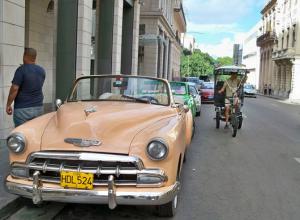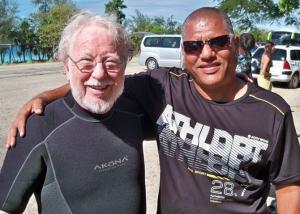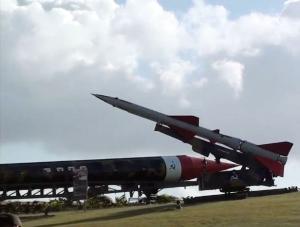Cuba's Bad Neighbor: An Athenian Traveler Behind Enemy Lines

In 1959 a revolution led by Fidel Castro overthrew Cuba’s right-wing dictator Fulgencio Batista.
Batista, the autocratic leader of Cuba from the 1930s and 40s, again had taken power in 1952 through a preemptive military coup during a losing bid to be democratically elected president. While dictator, he revoked most political liberties and aligned himself with United States interests that had been engaged in exploiting Cuba’s resources since the Spanish American War ended in 1898. These interests included domination of Cuba’s commerce and agriculture by U.S. corporations and the American mafia’s control of gambling, prostitution and illicit drug dealing in Cuba’s capital, Havana. Under Batista, the rich and connected got richer, and the poor stayed poor or became poorer.
When Fidel took over, he steered Cuba toward a central-planning, socialist economic model, ultimately suspended most political liberties, eliminated private ownership of real estate, nationalized Cuba’s businesses and agricultural production, got rid of organized crime and shut down gambling casinos, prostitution and drug trafficking. Under Fidel’s communista regime, the rich became dramatically poorer, and the poor, while they mostly remained poor, were given universal health care and nominal job security.
The United States government, through 11 different presidents, has been in a fit of pique over the actions of its small island neighbor ever since.

The trade embargo means most cars in Cuba are more than 50 years old.
In 1960, President Dwight Eisenhower imposed restrictions on trade with Cuba, then directed the Central Intelligence Agency to develop a secret plan to get rid of the Castro regime. In 1961, President John F. Kennedy authorized the CIA to proceed with the plan to invade Cuba, using hastily trained Cuban exiles bent on Castro’s overthrow. This poorly executed fiasco at the Bay of Pigs on Cuba’s southern shore was easily thwarted by Fidel’s forces armed with advance knowledge of details of the invasion.
Fidel then responded by cozying up more with a ready and willing Soviet Union. In early 1962, Kennedy broadened the trade restrictions into a complete embargo (after having his staff acquire 1,200 of his favorite brand of Cuban cigars) and instituted a ban on travel to Cuba by U.S. citizens. Later that year, Kennedy and Soviet Premier Nikita Khrushchev faced off over atomic bomb-tipped missiles the Soviets installed in Cuba. Nuclear holocaust was avoided when Khrushchev agreed to remove the missiles. Kennedy secretly promised never to invade Cuba and to remove U.S. nuclear-tipped missiles facing the Soviet Union in Turkey. Kennedy was assassinated just over a year later. Although there was never any proof that Cuba or the Soviet Union had anything to do with Kennedy’s death, for years afterward the CIA pursued multiple unsuccessful plots to assassinate Fidel, even once resorting to a failed exploding cigar scheme.
In 1980, President Jimmy Carter lifted the travel ban. Within a year, 100,000 Cubans had fled to America with Castro’s blessings, Fidel having emptied Cuba’s jails and mental asylums of some 20,000 persons, most of whom ended up in south Florida. In 1981, President Ronald Reagan re-imposed the travel ban and ordered a more severe U.S. trade embargo. During the 1990s, President Bill Clinton signed the Helms-Burton Act, which codified the U.S. trade embargo and sought to enforce it against other nations. Clinton wisely suspended portions of the Act that had succeeded only in pissing off most of the rest of the world that traded with Cuba. In 2003 and 2004, President George W. Bush, seemingly with an eye on Electoral College politics—Republican-leaning Cuban expatriates had by then achieved a strong political voice in South Florida)—rebuffed bipartisan initiatives in Congress to lift the embargo and travel restrictions, thereby becoming the modern era’s most zealous enforcer of the embargo.
Today, the Cold War is mostly a fading memory. Old foes such as China and Russia, and even hot war antagonist Vietnam, are important trading partners of the U.S. They may not necessarily be allies, but they no longer are considered enemies. Twenty-five years after the Soviets withdrew their military presence and economic subsidies, Cuba now seems the least likely of perceived foes in a radically different world. Yet the U.S. government continues to act irrationally and stubbornly hostile toward its small, insular, close-by neighbor.
After surviving U.S.-initiated assassination attempts, a 60-year-long trade embargo and political isolation, Fidel, old and ill, retired to his farm outside Havana in 2008. But his brother Raul and the Cuban Communist Party still rule, having outlasted eleven U.S. administrations, including President Barack Obama’s first term. This is not to say that the Cuban people have fared so well. Communism’s economic model usually assures everyone except the ruling bureaucracy will be relatively poor. However, it could be argued that the ordinary citizenry of Cuba are much better off than under Batista. Cuba’s free universal health care grades better in several categories than U.S. health care, according to the World Health Organization. While not necessarily a tangible measure of success, the Cuban people take pride in their perseverance in the face of persistent bullying by their giant neighbor 90 miles to the north.
America’s failed Cuba embargo still includes a general prohibition of travel by U.S. citizens to the island. Travel restrictions to Cuba have been loosened or tightened over the years, depending on political winds and whims. The Obama Administration recently loosened the embargo policy by allowing Americans of Cuban decent to go to Cuba to visit relatives. But most Americans who want to go to Cuba remain restricted to traveling with a State Department-licensed group for specified cultural or religious purposes. Visiting Cuba merely as a tourist is still deemed by our government to be a violation of the Trading with the Enemy Act of 1917. Cuba is the only nation against which this World War I vintage legislation is now directed. Constraints under the act aimed at bellicose North Korea were lifted in 2008. But in 2011 Obama, perhaps with a view toward Electoral College politics himself, issued an executive order extending the Act’s application to Cuba for two more years.
Cuba enjoys normal diplomatic and trade relations with virtually every nation on Earth except the United States. But America can’t get over its inability to control Cuba’s destiny. Our government keeping a travel leash on it own citizens is no less a totalitarian act than similar Cuban restraints on travel imposed on its citizens that the U.S. self-righteously denounces. As the world overwhelmingly has voted annually at the United Nations for more than 20 years, the U.S. needs, for its own sake, to rid itself of the failed embargo that has become a shameful embarrassment to our nation in the eyes of the world. It’s time for us to stop being Cuba’s bad neighbor.
Cuba Si! Yanqi Si!

The author with a Cuban friend.
This is where three retired senior citizens—Ken, a former UGA professor; Bill, an Alabama district judge; and me, a securities lawyer reveling in no longer having to toil as one—step into this story. Having wished for years to experience Cuba’s famed fishing (Ernest Hemingway wrote Old Man and the Sea while in Havana) and to SCUBA dive on Cuba’s almost virgin coral reefs, we found our hopes didn’t fit into any of the restrictive itineraries of the few cultural or religious groups allowed by the U.S. State Department to conduct visits to Cuba. Being too old and too ornery to put up with such injustice, we decided to create our own itinerary, as unfettered tourists. After engaging the help of a Canadian travel agency, we found the effort was not as hard as we thought it might be, and we had an adventure of a lifetime.
Our journey begins in early December on a Cubana Airlines flight from Cancun, Mexico to Havana’s Jose Marti Airport. After three colorful and easy days in Havana, we conclude our visit, somewhat ironically, at a spartan but pleasant Soviet-era beach resort flying the American stars and stripes in our honor—on the Bay of Pigs.
Since Cuba is deemed by the United States government to be an “enemy” requiring economic sanctions under the Trading with the Enemy Act of 1917, no American airline is allowed to provide regularly scheduled flights to our small neighbor lying just off the tip of Florida.
From sheer economic necessity, if for no other reason, Cuba’s communist government has encouraged tourism for more than a decade. Tourists from all corners of the globe except the United States enjoy Cuba. Americans who are not of Cuban descent with family in Cuba are not allowed—not by Cuba, but by our own federal government—to visit Cuba as tourists. Presumably, independent travel to Cuba by Americans just for the fun of it continues to be viewed by our politicians as a serious threat to their political security.
A friendly and responsive Canadian travel agency handled all the details. Our only responsibilities were to arrange our own travel from Athens to Cancun, Mexico, bring U.S. passports and incidental spending money (in Canadian currency or Euros; U.S. dollars are problematic), and sign up for Cuban government medical insurance. The U.S. embargo renders American credit cards, cell phones and insurance useless in Cuba.
Cubana Airlines has one daily roundtrip flight between Cancun and Havana. You miss that flight, and you might as well return home. So, we arrived at the Cancun International Airport, tickets and visas in hand, three hours before scheduled departure.
Our Canadian friends advised patience and tolerance in dealing with the Cuban entry process. “Cuban officials are not known for their easy manner. Expect rudeness,” we were warned. To our happy surprise, the opposite proves to be true. Even the persistent drug-sniffing dogs we encounter both before departure and after arrival are friendly enough to be adoption candidates. Discovering that our short flight to Havana would be on a modern Airbus 300 rather than on one of Cubana’s older Russian Iluyshins or Tupelevs gives our spirits a further boost.
We seem to be the only Americans among the 150 European, Canadian, Chinese and Latin American passengers on Cubana’s flight 153. After a smooth 45-minute flight, we wait in line to clear Cuban immigration, have our pictures taken (a requirement for all visitors to the island) and have our papers checked by an attractive, friendly female clerk who smiles and says “Welcome to Cuba” in perfect English.
Our 25-minute taxi ride brings us into Havana just as daylight gives way to a lush evening that introduces us to invigorating sounds of Cuba on a Friday night. Salsa music from automobile radios (ours and others) inspires young couples gathered in groups, smiles reflecting thoughts conjured by the songs. Vehicles on the roadway confirm the lore of the travel books. 1950s Chevys, Fords, Plymouths and Buicks are everywhere, along with an eclectic assortment of motorcycles, bicycles, small autos imported from China and a few heavy trucks left over from the Soviets. As we enter the narrow streets of “Old” Havana, handcrafted, three-wheel, human-powered “taxis” without lights or reflectors pedal passengers alongside and in between the autos and trucks.
We arrive at our hotel, the Parque Central, located as its name implies across from a memorial park in the center of Old Havana. The pre-revolution hotel, recently renovated and now managed by a Spanish company, caters to foreign tourists. The elegance and luxury of our accommodations amaze us. The hotel stands in stark contrast to the varying stages of genteel decay shown on most of the once beautiful structures in this historic district.
Since Castro opened Cuba to tourism in the 1990s, partially to counter the economic shock resulting from the loss of subsidies from the collapsed Soviet Union, the tourist industry has attracted many of Cuba’s best educated and talented. A bartender earning generous tips in an upscale hotel for foreigners can often earn more than a medical doctor in Cuba’s national health service.
For three easy days, we enjoy rooftop buffet breakfasts, walking the narrow streets and byways of Old Havana, drinking Cristal beer and Cuba Libres, rum and real Coca-Cola (the kind made in Mexico with cane sugar) at places like the La Floridita, billed as Ernest Hemingway’s favorite Havana bar, enjoying the many local entrepreneurial personalities seeking to sell something, entertain or serve as guides.
The Museum of the Revolution, just a few blocks from our hotel, is housed in Batista’s old palace. To our surprise, except for a few elderly women selling handmade souvenirs, we are the only people wandering around the museum’s mostly empty halls. Faded photographs and newspaper accounts of the revolution adorn the walls, along with real bullet holes left unrepaired after an attack on the palace during a student rebellion quashed by Batista not long before Fidel landed with his revolutionaries.

Ken and Grady in front of Cuba's Ministry of the Interior building, featuring the silhouette of Che Guevara.
On separate days we engage different drivers and their well-kept 1950s convertibles to acquaint us with the city beyond walking distance. We visit Plaza de la Revolucion, the huge memorial square measuring several city blocks. Fidel, before his retirement, held mass rallies at this site holding thousands spellbound with his revolutionary rhetoric. We find the plaza empty each time we visit. Across from the plaza is the Ministry of Interior building brandishing the iconic silhouette of Che Guevara.
The condition and appearance of the Havana waterfront reminds one of South Beach in Miami in the 1970s, just before the then-rundown art deco district was restored and transformed into luxury hotels, nightclubs and expensive residencies. Havana’s historic waterfront buildings are now either vacant or occupied as run-down tenements. The crumbling structures are poignant reminders of some of the grandeur, as well as the stark economic disparities, from colonial and post-colonial, pre-revolution eras.
Marlene, our contact in Havana arranged by the travel agency, meets us at our hotel to take us to an exceptional dinner at one of Havana’s private restaurants now allowed by Raul Castro. A native Cuban, Marlene speaks fluent English and Russian. She earned her degree in Nuclear Physics at Moscow University just prior to the collapse of the Soviet Union. The withdrawal of aid to Cuba by the Soviets put an end to her hopes of a career in developing nuclear power plants in Cuba. An attractive, intelligent and gracious host, she is well suited for the tourist industry.
By Tuesday, we are off to the Zapata Peninsula and our resort at Playa Largo on the infamous Bay of Pigs. Our driver, gregarious Conrado, born just before the revolution, fills the three-hour trip with stories of his and Cuba’s life under the Castro regime. He is filled with hope for change now that Raul has taken the reins of government from his brother. “Fidel outlived his shelf life,” he says.
The four-lane highway stretches for miles through sugar cane fields, small farms and forests. Small farmers are now allowed to sell their produce and keep the money, Conrado tells us. This has resulted in increased food production and better morale for the farmers. He grew up in the countryside, and is among the “wajeeros” (pronounced "waheros"), as he calls the rural population. The name, now somewhat synonymous with “hillbilly,” comes from the Spanish-American War. Teddy Roosevelt, after his successful charge against the Spanish on San Juan Hill, gathered the Cuban peasants around to thank them for their help in defeating the Spanish. “You are all war heroes!” he declared. No one could speak English, but they thought, if the American says we are wajeeros, we must be. So, according to Conrado, many rural Cubans to this day are referred to as wajeeros.
Stretches of the median of the highway are intermittently paved for a mile or so, but barriers have been placed on the paved portions of the median. Conrado tells us that Fidel paved the medians after the Bay of Pigs invasion, to allow Cuban Air Force planes easy landing and takeoffs when needed for defense of the countryside. Instead, the medians often were used by light aircraft flying in at night from south Florida to pick up relatives seeking to escape to the U.S. Barriers were placed to prevent further easy landings or takeoffs.
We turn right on a two-lane highway that cuts for 25 miles through the Zapata Peninsula. Zapata encompasses a huge protected wildlife area of rivers and swampland not unlike Florida’s everglades. The Bay of Pigs is a major feature of the Zapata shoreline. More romantic sounding in Spanish, the Bahia de Cochinos is known for its sandy beaches, beautiful coral reefs just offshore and excellent fishing—and for being the unlikely site of the failed invasion. Ken and I are there to scuba dive over the coral reefs and Bill, an expert at fly fishing, hopes to hook bonefish and tarpon.

After an educational stop at the Museum of the Bay of Pigs Invasion at Playa Giron, the beach village where most of the invaders were killed or captured before they could become a threat to Castro’s revolution, we check in at Playa Larga, just a few miles away. Each of us is heartily welcomed by the staff and assigned individual cottages, basic concrete block structures with minimal amenities built during the Soviet era. But there is air conditioning, plus palm trees and balmy breezes. The resort has a pleasant restaurant, two bars and a lovely beach. We enjoy Cristal beers and sandwich cubanas while Conrado details our fishing and diving schedules for the next two days.
The following morning, on the way to breakfast we see, to our astonishment, the Stars and Stripes billowing alongside the Cuban national flag on flagpoles at the hotel entrance. “The American flag is raised in your honor for being guests of Playa Larga and of Cuba," Conrado explains. We are indeed honored. Our Cuban adventure is everything we had hoped it would be.









comments